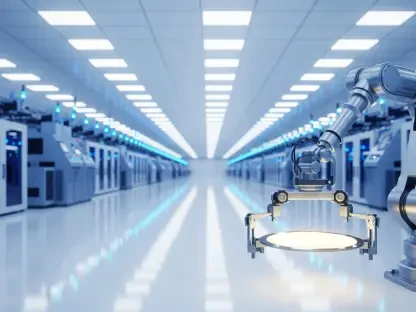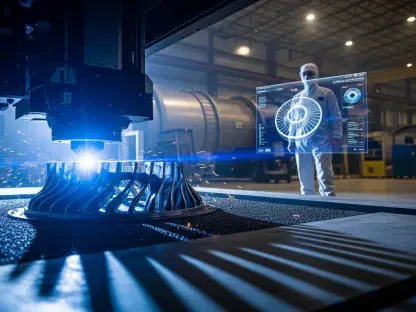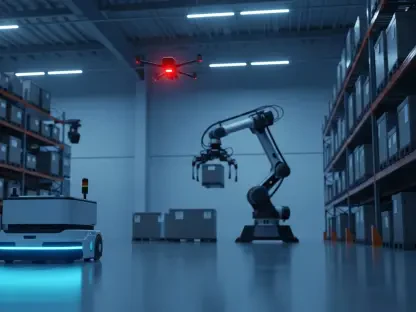The security of Industrial Control Systems (ICS) has become a pressing concern for critical infrastructure sectors such as oil and gas, manufacturing, and commercial facilities. The rise of sophisticated cyber threats targeting these systems has necessitated increased vigilance and robust cybersecurity measures. Recent advisories issued by the Cybersecurity and Infrastructure Security Agency (CISA) have highlighted significant vulnerabilities discovered in products from industry giants ABB, Rockwell Automation, and Inaba Denki Sangyo. These advisories reveal the existence of critical flaws that could enable attackers to gain unauthorized access, execute arbitrary commands, disrupt services, or take control of affected devices.
Critical Vulnerabilities Found in ICS Products
ABB RMC-100 Flow Computer
Among the vulnerabilities identified, the ABB RMC-100 flow computer has been noted for its prototype pollution in the web UI’s REST interface (CVE-2022-24999). This vulnerability, with a Common Vulnerability Scoring System (CVSS) rating of 8.7, underscores the urgent need for remediation to prevent potential exploits. ABB has advised users to update to newer software versions and to disable the REST interface when it is not in use as precautionary measures. The flaw allows attackers to manipulate the prototype chain, injecting malicious properties that can compromise the entire system.
Prototype pollution is particularly dangerous because it can lead to the execution of arbitrary code. Once an attacker exploits this vulnerability, they could alter the behavior of the web interface, making it possible to deploy further attacks or disrupt normal operations. For industrial environments relying on these flow computers for critical data processing, such disruptions can have severe consequences. The necessity for timely updates and the disabling of unused interfaces cannot be overstated, emphasizing the importance of regular cybersecurity hygiene and adherence to manufacturer guidelines.
Rockwell Automation’s Verve Asset Manager
Rockwell Automation’s Verve Asset Manager, versions 1.39 and prior, has been flagged for a vulnerability arising from insufficient variable sanitizing in the administrative web interface for the Legacy Active Directory Interface (CVE-2025-1449). This issue, rated 8.9 on the CVSS scale, highlights significant risks associated with old features and their potential exploitation. Rockwell Automation recommends upgrading to version 1.40, implementing security best practices, and utilizing secure remote access methods to mitigate these vulnerabilities.
The Legacy Active Directory Interface, being deprecated, presents a substantial security risk if not properly addressed. Insufficient variable sanitizing allows attackers to inject malicious data, leading to arbitrary command execution or unauthorized access. This underscores the broader challenge of managing legacy systems in industrial environments. Organizations must prioritize upgrading outdated software components and adopt rigorous security practices to protect against potential exploits. Regularly reviewing and deprecating outdated features is essential to maintaining a robust security posture.
Diverse Vulnerabilities and Defensive Strategies
Rockwell Automation’s 440G TLS-Z Safety Device
In addition to the Verve Asset Manager, Rockwell Automation’s 440G TLS-Z safety device, version v6.001, has been identified with a vulnerability in the STMicroelectronics STM32L4 component (CVE-2020-27212). This issue, with a CVSS score of 7.3, requires physical access and high technical capability to exploit, spotlighting the need for stringent physical access controls. Limiting access to authorized personnel and adhering to Rockwell’s System Security Design Guidelines are crucial to mitigating this risk.
Physical access vulnerabilities, while requiring an attacker to be on-site, can still pose a significant threat to industrial control environments. The compromise of safety devices not only impacts physical safeguarding but also the overall security posture. This calls for robust physical security measures, including controlled access points and regular monitoring. Following the security design guidelines provided by manufacturers ensures that systems are set up in accordance with best practices, reducing the risk of exploitability.
Inaba Denki Sangyo’s CHOCO TEI WATCHER mini
The final advisory issued by CISA concerns multiple vulnerabilities in the Inaba Denki Sangyo CHOCO TEI WATCHER mini (IB-MCT001). These include client-side authentication issues, weak password storage practices, insufficient password requirements, and forced browsing. With CVSS scores reaching as high as 9.3, these vulnerabilities pose significant risks. Currently, no patches are available, and users are advised to use the product within a secure LAN, employ firewalls and VPNs, and restrict physical access to authorized personnel.
Weaknesses in authentication and password management are highly exploitable areas within any system. Client-side authentication issues and weak password storage practices leave the system vulnerable to unauthorized access and data breaches. The lack of available patches necessitates the implementation of stringent network security measures. Organizations should ensure that the CHOCO TEI WATCHER mini operates within a secure network environment, utilizing firewalls and virtual private networks (VPNs) to create barriers against potential attacks. Limiting physical access further decreases the chance of exploitation, providing an additional layer of security.
The Need for Proactive Measures
Overall, the convergence of Information Technology (IT) and Operational Technology (OT) environments has brought both improvements and challenges in ensuring the security of critical infrastructure systems. With the increasing integration of these systems, there is a heightened risk of cyber threats targeting vulnerable points. CISA’s advisories emphasize the necessity of implementing patches where available, segmenting networks to protect vital systems, using secure remote access methods, and limiting physical access to sensitive devices.
Segmentation of networks effectively isolates critical systems from less secure segments, reducing the risk of a breach affecting the entire infrastructure. Secure remote access ensures that external connections are adequately protected against unauthorized entry, while careful control of physical access minimizes the risk of on-site tampering. These strategies, combined with the timely application of patches and updates, create a multi-layered defense against potential cyber threats. Organizations are encouraged to continually assess their ICS environments, perform regular audits, and adopt proactive defensive measures.
Ongoing Vigilance in ICS Security
No public exploitation of the discussed vulnerabilities has been reported yet, but this should not lead to complacency. The importance of proactive measures and thorough risk assessments cannot be overstated. Organizations must stay ahead of potential threats by implementing defensive strategies and reporting any suspected malicious activity to CISA immediately. This calls for a culture of continuous vigilance and adherence to best practices in cybersecurity.
The industrial control environment is constantly evolving, and so are the threats that target it. Therefore, it is crucial for organizations to remain informed about the latest vulnerabilities and adhere to recommended security protocols. Staying ahead in cybersecurity involves continuous education and adaptation, ensuring that systems are resilient against emerging threats.
Summary of Key Takeaways
The security of Industrial Control Systems (ICS) has become a critical concern for key infrastructure sectors like oil and gas, manufacturing, and commercial facilities. The surge in advanced cyber threats targeting these systems has demanded heightened vigilance and stronger cybersecurity measures. Recently, the Cybersecurity and Infrastructure Security Agency (CISA) released advisories highlighting significant vulnerabilities in products from industry leaders such as ABB, Rockwell Automation, and Inaba Denki Sangyo. These advisories uncover critical flaws that could permit attackers to gain unauthorized access, execute arbitrary commands, disrupt services, or take control of impacted devices. Such vulnerabilities put essential services at risk, emphasizing the urgent need for comprehensive security protocols to protect these vital systems. Companies must remain proactive in safeguarding their infrastructure from potential cyber-attacks to ensure operational resilience and continuity.









